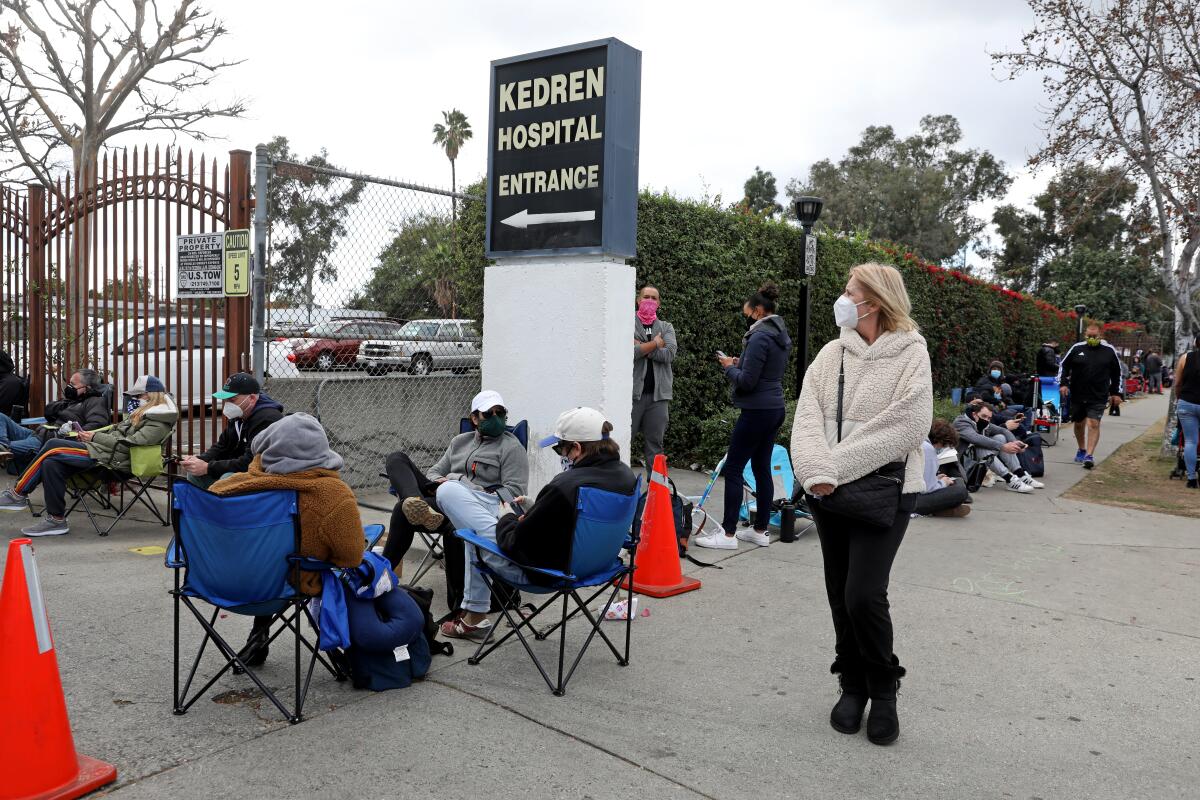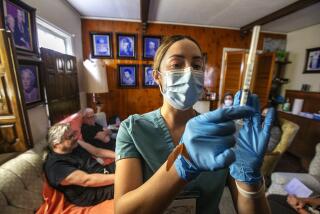Column: How a South L.A. doctor is beating the system and distributing vaccines equitably

- Share via
Even with a surgical mask covering his salt-and-pepper beard, it’s obvious when Dr. Jerry P. Abraham is scowling. He does that a lot as director of the always overwhelmed COVID-19 vaccination site at Kedren Community Health Center in South Los Angeles.
But there’s a special level of ire he reserves for the racial inequities he sees in vaccine distribution, which at Kedren Health is embodied by the dozens of young, mostly white people in yoga pants and beanies who lounge on beach chairs and blankets on the sidewalk every day. On Wednesday, there were dozens of them, many with MacBooks on laps, hoping to get leftover doses of the Moderna vaccine.
Next to them, a long line of anxious older people, most of them Latino or Black and from the surrounding neighborhoods, snaked down an adjacent sidewalk. Too many to count were leaning on rickety walkers and canes.
“This is the group of seniors — the walk-ups, plus the appointments. They kind of have to just wait somewhere while we figure out capacity. And this,” Abraham explained, pausing to glare at the vaccine chasers, “is the random line that people camped out in from like 8 p.m. the previous night.”
It’s a “Hunger Games”-like situation — caused by a shortage of vaccines and exacerbated by Los Angeles County’s messy system for distributing doses — that galls Abraham, an epidemiologist who has spent much of his career advocating for equity in healthcare.
It’s no surprise then that politicians and public health officials are now talking about fixing the raft of racial inequities that have cropped up as a result. Los Angeles isn’t alone either. Several recent surveys have unearthed a pattern of disparities among vaccine recipients in multiple states, which is particularly disturbing given that those most likely to get COVID-19 are also least likely to get inoculated.
“I know there’s large numbers of other populations that are getting the vaccine at higher rates than others,” L.A. County Supervisor Hilda Solis said Tuesday, “and I would just ask: What are we going to do?”
Abraham and his team at Kedren Health aren’t waiting for top-down fixes from politicians. In a matter of weeks, they have pioneered a number of workarounds to ensure that the people in South L.A. who need the vaccine most — healthcare workers and those over age 65 — can get it.
Politicians and public health officials — and, I suppose now Blue Shield of California — would be wise to follow Abraham’s lead to build a more equitable vaccine distribution system. That it is already being built in South L.A. is all the more important, given how this community has been clobbered by the pandemic, with the essential workers who live there, often in crowded conditions that make social distancing impossible, dying at disproportionate rates.
So that clunky online portal for making appointments?
Forget about it. Kedren Health is determined to help residents from South L.A., who often don’t have internet access, a computer or even a smartphone. Volunteers with paper forms are on hand to collect people’s information when they arrive and enter it into the county’s online database later. Many seniors have reported that technology is their biggest hurdle to getting vaccinated.
What about the need to have a vehicle, essential for getting vaccinated at drive-through sites such as the Forum and Dodger Stadium?
Forget about that, too. Kedren Health is one of only a handful of county-affiliated vaccination sites where people can arrive on foot instead of in a car.
Unfortunately, for those who do arrive by car, parking is chaotic — but that’s in no small part because of the affluent people from outside of South L.A. who camp out on the sidewalk all day. Their vehicles, which on Wednesday included Porsches and BMWs and Audis, take up far too many street parking spots for far too many hours.
And the line?
It’s long. But volunteers regularly check it to make sure that people who are seniors and frontline healthcare workers don’t get stuck behind those who aren’t eligible for the vaccine. There are also portable toilets on site.
What about not having a driver’s license or not speaking English?
Interpreters for almost every language spoken in South L.A. are on site. And immigration status doesn’t matter. Homeless people are also welcome.
“They deserve a vaccine just as much as everybody else,” Abraham said. “If they come here, they will leave with the vaccine in the arm. It creates a lot of headaches and challenges for us to report that information to the county and to the state and the federal government, but we will find a way.”
Abraham stuffed his brown hands into his white lab coat as he led me through a maze of blue and white tents hastily erected in the Kedren Health parking lot. Every few feet, he had to stop to answer questions. About a woman who was feeling itchy after the vaccine. About how many more doses they should distribute. About a chaplain who wanted to volunteer his services.
While he was talking, a group of men out on parole arrived from a transitional housing facility. They looked around warily, as dance music more fit for a nightclub blared in the background.
So far, more than 9,000 people, many of them Black and Latino healthcare workers, have received a first vaccine dose at Kedren Health.
Abraham doesn’t entirely buy the data released this week by the county Department of Public Health, showing a sharply lower rate of vaccinations for doctors and nurses who live in South L.A. compared to other regions. And he certainly doesn’t buy that the data are solely a reflection of vaccine hesitancy.
“It’s about access,” he said. “People didn’t know where to go.”
Eventually, Abraham says he wants to create a fleet of mobile units, so volunteers can take doses of the vaccine door to door or to homeless encampments. He and a group of other Black doctors and healthcare workers have started exploring grant funding to do it.
That way when there are doses left at the end of the day, Kedren Health can take them to elderly residents for whom standing outside in line is too dangerous. Or volunteers can set up a vaccination event at a church or community center to inoculate essential workers.
In some ways, Abraham’s motivation comes back to the under-65 crowd of vaccine chasers whom he scowls at on the sidewalk every day. Missing the mark on vaccine equity means having to summon one of them from a beach chair.
Sure, it’s better than throwing unused doses in the trash. Every vaccination is a step toward herd immunity. But with the yawning need among Black and Latino people in South L.A., well-off white people aren’t who he wants to vaccinate.
“To come here and demand or to feel this sense of entitlement, or because you don’t need to work or because you have those luxuries and you can sit here,” Abraham said, “those people I’m not proud of vaccinating.”
More to Read
Sign up for Essential California
The most important California stories and recommendations in your inbox every morning.
You may occasionally receive promotional content from the Los Angeles Times.











